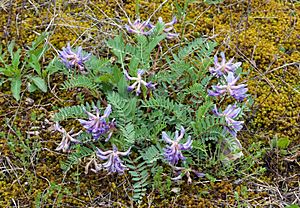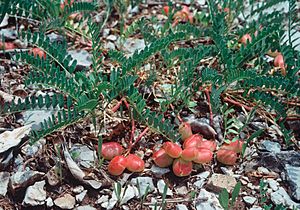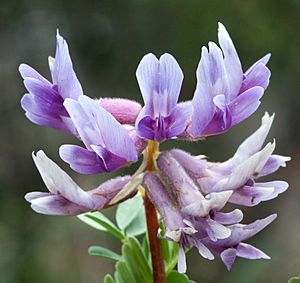Limestone glade milkvetch facts for kids
Quick facts for kids Limestone glade milkvetch |
|
|---|---|
 |
|
| Conservation status | |
| Scientific classification | |
| Genus: |
Astragalus
|
| Species: |
bibullatus
|
Astragalus bibullatus, also known as the limestone glade milkvetch or Pyne's ground plum, is a special flowering plant. It is an endangered species, meaning it is at risk of disappearing forever. This plant is found only in a small area of Tennessee in the United States.
It grows in unique places called cedar glades. These are open areas with thin soil over limestone rock. All known populations of this plant are located in Rutherford County, Tennessee, very close to each other.
Contents
Discovering Pyne's Ground Plum
Scientists Rupert Charles Barneby and Edwin L. Bridges first officially described Astragalus bibullatus in 1987. The common name "Pyne's ground plum" honors Milo Pyne. He was the person who found this plant in the 1980s.
The name "ground plum" comes from its unusual fruits. These fruits are smooth and reddish. They ripen on the ground and look a bit like small plums. However, this plant is a legume, like beans or peas. It is not related to true plums, which belong to the rose family.
How to Identify This Plant
Astragalus bibullatus looks similar to another plant found in cedar glades, the Tennessee milkvetch (A. tennesseensis). But there are clear differences.
The stems, leaves, and fruits of A. tennesseensis are all fuzzy. In contrast, A. bibullatus has smooth stems, leaves, and fruits. The flowers are also different. A. bibullatus has pinkish-purple flowers. A. tennesseensis has yellow-white flowers.
The fruits are quite distinct too. A. tennesseensis fruits are green and hairy. They are also more elongated, looking a bit like an elf's shoe. This shape is more typical for legumes. The flowers of A. bibullatus bloom in April and May. Its fruits then ripen in May or June.
Why This Plant Needs Our Help
Astragalus bibullatus is an endangered species because it lives in only a few places. This makes it very vulnerable to habitat loss. When its natural home is destroyed, the plant has nowhere else to go.
Fortunately, efforts are being made to protect this unique plant. Eight of its populations are now safe. These protected areas include the Flat Rock Cedar Glade and Barrens State Natural Area and Manus Road Cedar Glade. Protecting these special places helps ensure the future of Pyne's ground plum.
Images for kids
See also
 In Spanish: Astragalus bibullatus para niños
In Spanish: Astragalus bibullatus para niños





